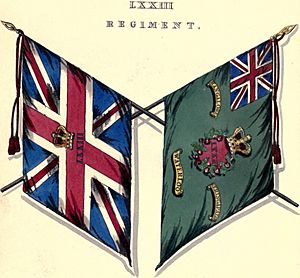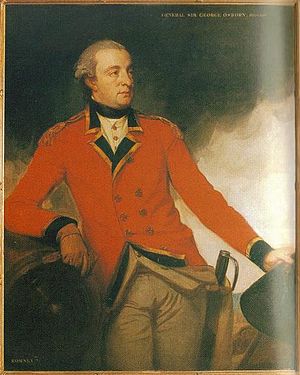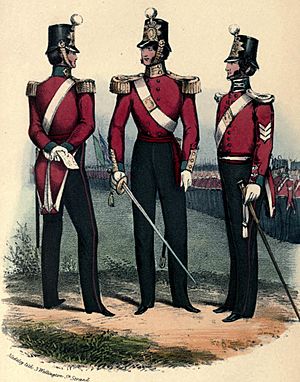73rd (Perthshire) Regiment of Foot facts for kids
Quick facts for kids 73rd (Perthshire) Regiment of Foot |
|
|---|---|

Regimental colours
|
|
| Active | 1780–1881 |
| Country | |
| Branch | |
| Type | Infantry |
| Size | One battalion (two battalions 1809–1817) |
| Garrison/HQ | Hamilton Barracks |
| Engagements | Second Anglo-Mysore War Third Anglo-Mysore War French Revolutionary Wars Fourth Anglo-Mysore War Napoleonic Wars Second Kandyan War Uva Rebellion Seventh Xhosa War Indian Rebellion |
The 73rd Regiment of Foot was a group of soldiers who fought on foot (called infantry) in the British Army. It was created in 1780. Later, in 1881, it joined with another famous group, the 42nd Regiment of Foot, to become part of the Black Watch (Royal Highlanders). This happened because of some big changes in the army called the Childers Reforms.
Contents
The Story of the 73rd Regiment
The 73rd Regiment of Foot had a long history, serving in many parts of the world. They were involved in important battles and events, showing courage and dedication.
How the Regiment Started

The regiment began in March 1780 as the 2nd Battalion of the 42nd (Royal Highland) Regiment of Foot. Eight officers from the 1st Battalion helped to create this new group of soldiers.
In January 1781, the battalion traveled to India. They took part in the siege of Mangalore in 1783 during the Second Anglo-Mysore War. This was a big fight in India.
The battalion was still in India when it became its own regiment in 1786. It was then called the 73rd (Highland) Regiment of Foot.
Early Battles in Asia
The new regiment stayed in India and fought in several important battles. They were at the siege of Seringapatam in 1792 during the Third Anglo-Mysore War.
They also helped capture Pondicherry in August 1793 during the French Revolutionary Wars. Then, in 1795, they helped take over Dutch settlements in Ceylon.
In April 1799, they were part of the attack force at the siege of Seringapatam during the Fourth Anglo-Mysore War. After many years abroad, the regiment returned to England in July 1806.
The Regiment During the Napoleonic Wars
The Napoleonic Wars were a series of major conflicts between France and other European powers. The 73rd Regiment played a role in these wars.
The 1st Battalion's Adventures
In April 1809, the regiment created a second battalion in Nottingham, England. At this time, they stopped being called a "Highland" regiment because it was hard to find enough recruits from the Highlands. They became simply the 73rd Regiment of Foot.
The 1st Battalion set sail from Yarmouth in May 1809 for a long, seven-month journey to New South Wales, Australia. Their job was to help the new Governor, Lachlan Macquarie, take control after the previous governor, William Bligh, was removed from power. This event was known as the Rum Rebellion.
In 1810, more soldiers joined them from another group called the New South Wales Corps. The commander of the 73rd Regiment, Maurice Charles O'Connell, married Governor Bligh's daughter. This caused some tension with the leaders of the Rum Rebellion.
To ease these problems, most of the battalion left New South Wales in April 1814. They sailed to Ceylon. While in Ceylon, the battalion was led by Lieutenant Colonel Andrew Geils. Sadly, in May 1815, many wounded soldiers and Geils's children died when their ship, the Arniston, sank after visiting him.
The battalion fought in the Second Kandyan War in Ceylon in 1815. After the 2nd Battalion was disbanded in 1817, about 300 of its soldiers joined the 1st Battalion in Trincomalee. In that same year, the regiment helped put down the Uva Rebellion. They lost 412 out of about 1,000 men in this conflict.
The 2nd Battalion at Waterloo
The 2nd Battalion stayed in England until May 1813. Then, they were sent to Swedish Pomerania and fought in the Battle of the Göhrde in September 1813. They also fought at the Battle of Merxem in January 1814.
In 1815, the battalion joined Wellington's Army in Belgium. They were part of a larger group called the 3rd Division.
The battalion fought bravely at the Battle of Quatre Bras on June 16, 1815, where 53 of their men were killed or wounded. Two days later, they faced the famous Battle of Waterloo on June 18.
At Waterloo, the regiment was attacked by French cavalry (soldiers on horseback) 11 times! They were also heavily shelled by French artillery. But they held their ground in a defensive formation called an infantry square and did not break.
The battalion lost 6 officers and 225 men killed or wounded. This was the second-highest number of casualties for an infantry regiment in that battle. After the battle, the battalion was part of the army that occupied Paris before returning to England in December 1815.
The Victorian Era and Beyond
After their service in Ceylon, the regiment returned home in November 1821. They were then stationed in Gibraltar in 1827 and Nova Scotia in 1838.
After coming back to England in June 1841, the regiment successfully got its "Highland" status back. In 1845, they were renamed The 73rd (Highland) Regiment of Foot.
The Birkenhead Disaster
In January 1846, the 73rd Highlanders arrived in Argentina to protect British interests during the Uruguayan Civil War. After this, they sailed to the Cape Colony to fight in the Seventh Xhosa War.
In 1852, a group of soldiers from the regiment left Simon's Town on a ship called HMS Birkenhead. They were heading to Port Elizabeth.
Early in the morning on February 28, 1852, the ship hit rocks near Danger Point. The soldiers gathered on deck and bravely allowed the women and children to get into the lifeboats first. They then stood firm as the ship sank, even when told that jumping into the water might upset the lifeboats and endanger the civilians. Tragically, 357 men drowned. This event became famous for the soldiers' bravery and discipline.
Later Years and Amalgamation
In 1857, the regiment helped to stop the Indian Rebellion in Central India. In 1862, they received a new name: the 73rd (Perthshire) Regiment of Foot.
The regiment was sent to Hong Kong in 1866, back to Ceylon in 1871, and then to India in 1874.
In the 1870s, there were big changes in the British Army called the Cardwell Reforms. These reforms linked single-battalion regiments together. The 73rd was linked with the 90th Regiment of Foot (Perthshire Volunteers) and assigned to a training base at Hamilton Barracks.
Finally, on July 1, 1881, the Childers Reforms came into effect. The 73rd Regiment joined with the 42nd Regiment of Foot, the very regiment they had originally started from 95 years earlier. Together, they formed the famous Black Watch (Royal Highlanders).
Important Battle Honors
The 73rd Regiment earned special recognition for their bravery in these battles:
- Anglo-Mysore Wars: Mangalore, Seringapatam
- Napoleonic Wars: Waterloo
|




